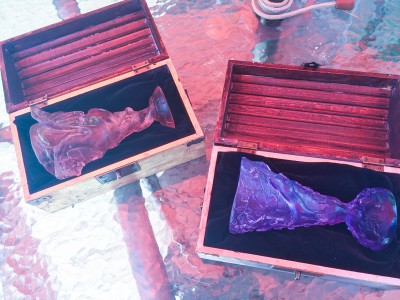So...I handwork more often than machine polish, and don't really have a lot of trouble getting a high gloss on the glass. It depends, as usual, on the piece, the glass, and how much time you have.
These goblets are Gaffer lead crystal, about 7-8 inches high. I polished the relief elements to a high gloss and left the foundation pretty much in its from-the-mold state (which was, fortunately, a nicely satin finish). I started with 400-grit wet-dry and a tub of water, moved from 600 to 800 to 1200 and touched it up with cerium handpads (from HIS Glassworks). It took about 2 hours per goblet. (I did have some additional machining to remove excess glass from the base, and knock off some flashing from the inside, but that was pretty much it for machine work). Gaffer coldworks like butter, to the point that I'd rather handwork than risk going too far with the machine.

This 2-inch pendant is soda-lime (Bullseye), cast and extensively shaped with a foredom diamond wheel to remove the (rather large) glass sprue and rough-shape it into the current form at a level of about 200-grit. At that point, I switched to handworking, took it to a very high gloss with diamond hand-pads and then wet-dry sandpaper with a cerium pad finish. All told, there's about 6 hours of coldwork into this piece, maybe 4 of it in handwork. That's partly because soda-lime is harder than lead crystal and just takes longer to work, partly because the smaller you go the more difficult it can be to polish detail (there's only so much surface to hold the grit).

I have a harder time coldworking float than Bullseye--it shouldn't be that much harder than any other soda lime glass, but it sure seems to be. This float glass casting has optically polished edges, acting as windows to the interior. I didn't want to flatten the contours, so started out entirely hand-polishing these. At 4 hours I'd only reached 400 grit on ONE side, and ran out of time. Gave it to my coldworking guy to optically polish, and he zipped through in about an hour.
If you do it right, the cerium step is the shortest--you're removing successively less material every time you step up the grit, so by the time you get to cerium there's not much left to do except polish (in fact, if I'm using 1200/1600-grit wet-dry, I sometimes don't even need the cerium step).
The biggest problem I have with cerium is its tendency to embed in pinholes like glue, so that your formerly pristine surface appears to have blackheads all over. My mom told me to get a bar of soap, rub it all over the glass to fill every pinhole. Then process, occasionally pressure-washing the piece to clean out the holds, then renewing the soap. It works like a charm; I keep a bar of my soap near the coldworking station all the time now.
